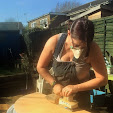I'm not sure if bloggers will be able to follow this link to an interesting article by Martin Shovel of CreativityWorks, published in Training Zone. It might require registration... I forget.
However, there are some interesting points I'd like to tease out:
Perhaps trainers and teachers could learn some useful lessons about multi-sensory learning from the world of advertising. There's almost always a strong synaesthetic dimension to persuasive advertising campaigns.
The article is promoting the use of cartooning for teaching and learning:
The graphic simplicity and directness of cartoons can be used to evoke smells, sounds, feelings and tastes, as well as the emotions that accompany them.
It's a strong argument and I can see that it can prove a very useful learning tool. However, why stop at evoking sounds, smells etc. Why can we not use the real thing? Or somehow harness the power of these senses to improve retention? Vicki Davis (Coolcat teacher) refers to this in point 8 of her typology of cognitive pleasures in the classroom:
Involve all of the senses: touch, sight, hearing, and yes, even taste and smell. Do you know how I teach the students to participate in Socratic discussions. (Some of you will hate this and criticize me greatly!) I use food...Many of our best class discussions are on the days we have candy. It's not a big piece, sometimes Starbursts, sometimes chocolate.
How many of us are transported back to a given moment in our lives by a smell, a sight, a sound, a taste, a touch sensation? For me, there is a certain smell that transports me back to the time I saw the (dreadful) movie Jesus of Nazareth when I was 15. For my husband, the smell of birch and/or beech trees transports him back to the tiny island off the coast of Sweden where he spent idyllic childhood summer holidays with his grandfather.
We encounter the notion in literature and movies all the time - sadly usually in connection with something awful. For Matt Freeman, hero of the Power of Five series by Anthony Horowitz, his telekinetic/precognitive ability is always accompanied by the smell of burning toast: the first time it manifested, his mother had just burnt the breakfast toast.
Works of fiction have also explored the deliberate and callous harnessing of this concept: River, in Serenity turns from a docile, somewhat unbalanced teenager into a veritable killing machine thanks to some subliminal messaging; for Danny in Unleashed (aka Danny the Dog) the removal of his dog collar has much the same result.
But sensory conditioning goes back a long way: think Pavlov and his dog. Just because we've moved on from behaviourism as a viable teaching method, does this mean that we are done with fostering connections between information and the senses?
If it involves chocolate, improves retention and enhances the level of learning, I certainly hope not!


2 comments:
Pavlov had some great experiments but it is precisely Pavolov's dogs (and a desire to keep the room clean) that have so conditioned some educators against engaging all of the senses.
I know some educators who wouldn't dream of giving standardized testing without giving the kids gum. They think that one "trick" does more than anything to keep their minds working.
Children aren't dogs. They certainly ARE human, as are adults. I think this is why good trainers always keep a bowl of candy (including chocolate) on the tables in front of adults as well as water. They insist on snacks and coffee at break. They know when a person's mouth is engaged eating that they aren't talking and most often they are listening. Same principle as a "squish ball", I guess.
This is an excellent post. I appreciate your comments and correcting my link on my blog! You are truly a great blogger and I always LOVE your comments because they are so insightful!
Thanks, Vicki. I hope you don't think that I was drawing a comparison between dogs and learners. Because if so, I must hastily point out that was not my intention. However, it was in exploring how learning takes place that Pavlov did his experiments. I think (and I may be wrong, here) that it was because teachers and learning practitioners decided that results of tests on dogs were not a true indicator of human learning that gave rise to the learning theories that followed.
And you're right that adults are not that different from children. In my years as a classroom-based trainer, I was also a supporter of the bowl of sweeties on the desk option... and the reward system: books, music vouchers, beauty salon vouchers.
I once attended a presentation by Mary Gober www.marygober.com at the World of Learning Conference. She was talking about customer service - an area very dear to my heart, and (in my view) pivotal to success as a teacher/trainer/whatever. She would ask the audience to shout out suggestions in various situations and, every time a person made called out something she agreed with, she would toss them a bag of chocolate coins, saying: "You're right on the money". I would never have believed the impact that this would have in England, the home of the cynic! There we were, this reserved British audience, volubly competing for chocolate. It was the best seminar of the conference, and not just because of the sweeties - I have remembered and applied several of the principles she taught.
AND I came away with 4 bags of chocolate coins!
Post a Comment